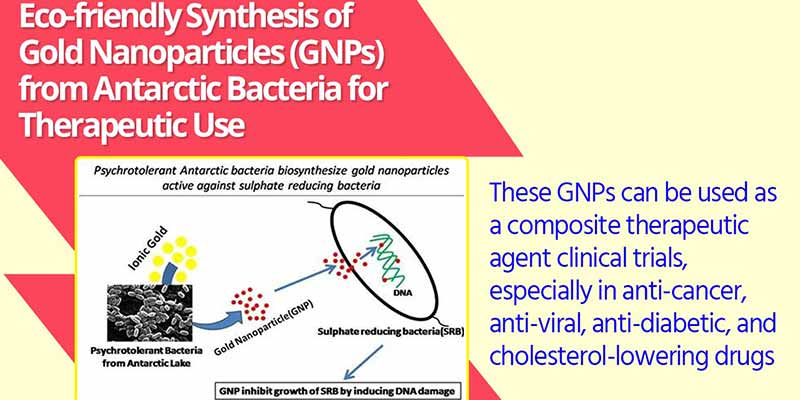- India
- Jun 30
Explainer / Gold nanoparticles
Researchers of the National Centre for Polar and Ocean Research (NCPOR) and the Goa University (GU) have synthesised gold nanoparticles (GNPs) using psychrotolerant Antarctic bacteria through a non-toxic, low-cost, and eco-friendly way.
The study by NCPOR and GU established that 20-30-nm-sized spherical-shaped GNPs could be synthesised in a controlled environment. These GNPs can be used as a composite therapeutic agent in clinical trials, especially in anti-cancer, anti-viral, anti-diabetic, and cholesterol-lowering drugs.
Use of psychrotolerant Antarctic bacteria is found to have special advantages like mild reaction conditions to reduce gold ion to GNPs with a good dispersion capability.
What are gold nanoparticles (GNPs)?
Nanotechnology is a field of applied science and technology that creates new and novel materials through controlled manipulation at a size range of 1 nm (nanometer) to 100 nm (1 nm equals to 10-9 m).
Nanoparticles are those materials that are at least one dimension smaller than 100 nanometres. Nanoparticles have a high surface-to-volume ratio and they can provide tremendous driving force for diffusion, especially at elevated temperatures.
Nanoparticles have a wide variety of potential applications in the fields of biomedical, optical and electronics research. Metallic nanoparticles have been efficiently exploited for biomedical applications and among them gold nanoparticles (GNPs) are found to be effective in biomedical research.
GNPs are melted at much lower temperatures (300°C) than bulk gold (1064°C).
GNPs are found to have greater solar radiation absorbing ability than the conventional bulk gold, which makes them a better candidate for use in the photovoltaic cell manufacturing industry.
GNPs have unique optical properties. For example, particles above 100 nm show blue or violet colour in water, while the colour becomes wine red in 100 nm gold colloidal particles. They can thus be used for therapeutic imaging.
GNPs have unique physicochemical properties. Their biocompatibility, high surface area, stability, and nontoxicity make them suitable for various applications in therapeutic use including detection and diagnosis of diseases, bio-labeling, and targeted drug delivery.
As nano-carriers, GNPs are capable of transferring various drugs made out of peptides, proteins, plasmid DNAs, small interfering RNAs, and chemotherapeutic agents to target diseased cells of the human body.
Scientists have constructed a transistor known as NOMFET (Nanoparticle Organic Memory Field-Effect Transistor) by embedding GNPs in a porous manganese oxide as a room temperature catalyst to break down volatile organic compounds in air and combining GNPs with organic molecules. NOMFETs can mimic the feature of the human synapse known as plasticity, or the variation of the speed and strength of the signal going from neuron to neuron. These novel transistors can now facilitate better recreation of certain types of human cognitive processes, such as recognition and image processing and have their application in artificial intelligence.
National Centre for Polar and Ocean Research
The National Centre for Polar and Ocean Research (NCPOR) was established in Goa in 1998 as an autonomous R&D institution of the ministry of earth sciences (formerly Department of Ocean Development).
The centre is designated as the nodal organisation for the coordination and implementation of the Indian Antarctic Programme, including the maintenance of India’s permanent station in Antarctica.
Year-round maintenance of the two Indian stations (Maitri & Bharati) in Antarctica is the primary responsibility of the centre. Maitri (1989) and Bharati (2011) were established, for carrying out research by the Indian scientists in all disciplines of polar research.
Manorama Yearbook app is now available on Google Play Store and iOS App Store

